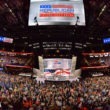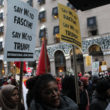DID WE JUST WITNESS THE DYING GASP of hate-based Christianity? While Dr. James Dobson might not know it, electoral demographics strongly suggest that we did.
On the eve of the election, Dobson circulated a sixteen-page letter signed by “A Christian from 2012.” Dobson’s non-profit Focus on the Family organization took in more than $142 million (in what must have been something other than profits) in 2007, according to IRS filings. Its 2008 budget is reported to be $160 million. The reach of Dobson’s multi-media combine is vast; his international radio audience is said to be 220 million, his website a regular stop for many evangelicals, his newsletter widely circulated. So it’s safe to assume that his letter, like much of what Dobson markets, was widely read.
In his dispatch from an imagined fourth year of an Obama presidency, Dobson describes a secular dystopia in which the Boy Scouts have disbanded because an Obama Supreme Court has ruled that Scouts are required to sleep in tents with gay Scoutmasters; pornography dominates daytime television because the High Court has defined pornography as speech protected by the First Amendment; organizations such as Campus Crusade for Christ, Baptist Campus Ministry, and the Reformed University Fellowship have all but disappeared because the same imaginary Court has ruled that “proselytizing” and “worship” do not enjoy the same First Amendment protections as pornography; countless aborted late-term infants are killed just seconds before they are born; churches are stripped of their tax-exempt status; and gays and lesbians are guaranteed a constitutional right to wed. (The final two provisions read like sound and equitable public policy.)
Dobson’s epistle even describes a fictitious Supreme Court ruling that contradicts his own canonical interpretation of the Second Amendment and restricts the rights of the gun owners that the Roberts Court protected in District of Columbia v. Heller, which Dobson cites in the letter. (Dobson’s obsession with handguns is peculiar; the nearest that the Christ came to engaging in violence was his turning against the Temple money-changers, who were precursors to Dobson, John Hagee, Pat Robertson, and others who turn places of worship into profit centers.)
The letter is over the top, even by Dobson’s degraded standards. A CNN reporter describing it called Focus on the Family “religious extremists.” The Rev. Jim Wallis, an evangelical minister who focuses on the social justice message in the Gospels, wrote on his blog: “James Dobson, you owe America an apology.” “A Christian Bipartisan Rejection of Focus on the Family’s Letter from 2012” is attracting members on Facebook. And a website that describes Planned Parenthood “abortion parties” and “baby work camps” as the logical conclusion to “Chairman Obama’s anti-life platform” is a spot-on satire of Dobson’s letter.
The collective response to Dr. Dobson’s failed attempt to influence the election might be described as the sound of America gagging.
VANISHING “VALUES VOTERS”—No one expects Dr. Dobson to change.
The American electorate, however, moves in mysterious ways. While it is premature to describe anyone who controls a media and publishing business as large as Dobson’s as “irrelevant,” among the voters who made history along with Barack Obama were the surprising number of evangelicals and Roman Catholics who voted for him.
Dr. Dobson read the pre-election polls, which perhaps explains the desperation evident in his “Letter from 2012 in Obama’s America.” White evangelical voters did not walk away from the Republican Party. According to the Pew Forum on Religion and Public Life, John McCain won 74 percent of the nation’s white evangelical vote.
But as New York Times religion writer Laurie Goodstein reported, the Obama campaign peeled away evangelical voters in swing states, where the campaign made a concerted effort to reach them. In one striking example, the Democratic presidential campaign invested heavily in Colorado, the American evangelicals’ Vatican and home of Focus on the Family and a number of big-box congregations, including the New Life Church, formerly led by disgraced pastor Ted Haggard. The result was a 10-point increase in Democratic support among white evangelical voters in Colorado—an increase that helped Obama carry the previously red state. Goodstein also reported on Obama’s visits to ten Christian colleges in swing states and the campaign’s calculated attempt to reach out to young white evangelicals.
On the same front, Matthew 25, a political action committee (PAC) created to promote Obama’s Christian faith among conservative Christians, also pursued younger evangelical voters. Late in the campaign, the group was running ads on Christian radio stations in Colorado, Michigan, Ohio, Missouri, Indiana, North Carolina and Virginia. Its videos took on their own viral afterlife, circulating on YouTube and other free-content Internet sites. The almost unnoticed outreach campaign made substantial gains among evangelicals between ages 18 and 44, where Obama doubled the numbers turned out by John Kerry in 2004.
David P. Gushee, a professor of Christian ethics at Mercer University and author of The Future of Faith in American Politics, told Goodstein that there is a generational division among evangelical Christians. Younger evangelicals, he said, are attracted to an agenda beyond abortion and homosexuality, and that includes issues such as the environment, poverty, human rights, and torture.
Obama also won 54 percent of the nationwide Roman Catholic vote, according to Pew’s exit polling. That’s a 7-point improvement over Senator John Kerry’s 47 to 52 percent loss to George W. Bush among Catholics in 2004.
White evangelical voters, 25 percent of the total electorate, will remain the Republican Party’s base—a mixed blessing in a country in which the political center has dramatically shifted toward the left. But according to political demographer Ruy Teixeira, white evangelicals are not growing as a percentage of the electorate. “The big growth demographic,” Teixeira said at a Progressive Policy Institute post-election conference in Washington, “is people who are secular and don’t attend Church.” Teixeira describes this secularization trend as the growth of a non-Christian coalition. “If you fast forward to 2024,” he said, “non-Christians will represent 45 percent of U.S. adults.” Seventy-five percent of them voted for Obama.
The evangelical Republicans’ best hope now lies in a failed Obama administration. That portends an escalating campaign of vilification among Christian extremists like Dobson. It also suggests that journalists and advocacy groups should remain focused on the country’s radical religious right.
WHISTLING DIXIE—The decline of GOP support among moderate evangelicals, and the diminishing relevance of evangelical voters in elections, is not the only bad news for Republicans. Forty years after Nixon launched his Southern Strategy—designed to end Democratic hegemony in the South by labeling the Democratic Party the party of civil rights and consolidating the support of what Nixon strategists called “Negrophobes”—Republicans have won the war. They are the undisputed party of the Confederacy.
At the PPI conference in Washington, Teixeira, who in 2002 co-wrote with John Judis the prescientThe Emerging Democratic Majority, did the numbers.
Since 1998 ethnic minorities as a share of the electorate have increased from 15 to 25 percent. Most are voting for Democratic candidates, particularly in national elections.
Democrats won 80 percent of the minority vote this year. Blacks supported Obama by an unsurprising 96 to 4 percent margin. In 2004 an incumbent President Bush won 44 percent of the Hispanic votes cast, far better than any previous Republican presidential candidate. In 2008 Obama won 67 percent of the Hispanic vote, to McCain’s 31 percent.
Hispanics had the greatest impact in Colorado, Nevada, New Mexico, and Florida, all states that Obama moved from the Republican to the Democratic column in one election cycle. The return of Hispanic voters to the Democratic Party, after Bush and his election strategist Karl Rove worked so hard to win them over, is another setback for the Republican Party’s prospects in national elections.
Republicans also slipped into a recession among educated professionals, among whom Obama led by 18 percent.
But the most ominous voting trend confronting the GOP is the young voters to whom Obama has laid claim. On the eve of the election, Pew Research Center polling gave Obama a 29 percent advantage among voters born after 1978, the so-called “millennials.” Pew’s exit polling gave Obama 66 percent of these voters under thirty. “That’s lights out for the Republicans,” said Teixeira.
This year, 48 million millennials were eligible to vote;in 2012 that number will increase to 64 million; by 2016 to 80 million. Like suburban voters, another demographic with whom Republicans lost ground, most millennial voters are deeply offended by the moral authoritarianism that has become the signature mark of a party indentured to the extreme religious right.
The only glimmer of good news for Republicans was its white working-class support. Call it Sarah Palin’s and Joe the Plumber’s voting block. But white working-class voters are also diminishing in importance, having fallen by 15 percent as a share of the electorate over the past thirty years.
There is, it seems, no exit for the Republicans. Reach out to millennial voters and suburbanites by abandoning the “guns, God, and gays” campaign—by which the party won the past two presidential elections—and lose the Christian base and the Southern white vote. Turn up the heat on these “values” issues and risk alienating the voting block that will determine the next three presidential elections.
At the same Progressive Policy Institute post-election conference in Washington, The Atlantic’s senior editor Ross Douthat tried to “what if” a different George W. Bush administration in the direction of different election results. Little of what the Democrats did in would have mattered so much, he said, “if the U.S. had found weapons of mass destruction in Iraq; if Paul Bremer’s pro-consul had been much more effective in governing Iraq; if Katrina had made landfall somewhere other than New Orleans; if Alan Greenspan had made slightly different decisions in his calculations having to do with regulation of the financial system.” It’s an argument that begs the question and misses the point. The larger issue that Douthat, a social conservative, misses, is that the Republican Party is on the wrong side of large demographic shifts. The party faces what seems like a terminal dilemma.
Political fortunes can change, of course, and this election wasn’t only about demographics. The campaign Barack Obama ran was smarter, more disciplined, better executed, and better funded than any presidential campaign in modern history. The failed Bush presidency was an asset for Democrats.
It’s a safe bet that for the next four or perhaps eight years, the White House will not be calling James Dobson to ask his blessing for a Supreme Court nomination—as Karl Rove did when he tried to sell Harriet Miers to evangelical extremists holding the note on the Republican Party.
The “permanent political realignment” that Karl Rove promised eight years ago has finally taken place. Republicans are locked into a white evangelical Southern coalition they should hold for at least twenty years.






0 Comments